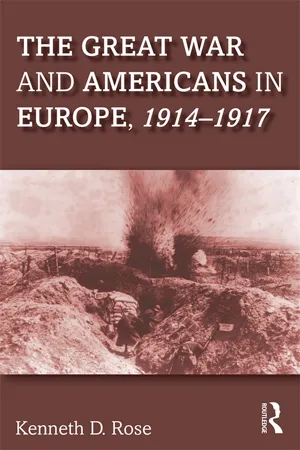History
Militarism
Militarism refers to the belief or desire of a government or people that a country should maintain a strong military capability and be prepared to use it aggressively to defend or promote national interests. It often involves the glorification of military virtues and a focus on military power as a means of achieving political and social goals.
Written by Perlego with AI-assistance
Related key terms
5 Key excerpts on "Militarism"
- eBook - ePub
The Hollywood War Machine
U.S. Militarism and Popular Culture
- Carl Boggs(Author)
- 2017(Publication Date)
- Routledge(Publisher)
Chapter 2 Militarism in American Popular Culture At the start of the twenty-first century the United States has emerged as the greatest military power in history, an empire possessing all the features of a mature warrior society: permanent war economy, expanded security state, vast armed presence around the world and in space, a militarized order unlike anything ever known. It is a system increasingly grounded in—more accurately, addicted to—the deadly but profitable mobilization for warfare, a system that celebrates the spectacle, technology, great successes, and above all power that Militarism brings to a political order bent on global domination. While such an order cherishes and indeed fetishizes the ethos of armed power, its reproduction demands a far-reaching culture of Militarism that enters into and transforms the daily life of a population willing (under definite conditions) to give its consent to imperial adventures. Militarism appears as a form of ideology, a rationality that deeply influences the structures and practices of the general society through storytelling, mythology, media images, political messages, academic discourses, and simple patriotic indoctrination. While the intimate connection between institutional and cultural modes of power, between the military and daily life, is scarcely new, it has taken on new dimensions with the dramatic growth of media culture (including film) over the past few decades. If the culture of Militarism endows warfare agendas with a popular sense of meaning and purpose, it also represents the hegemonic facade behind which corporate and Pentagon domination can more or less freely assert itself, both domestically and worldwide. The decay of American economic, political, and social life cannot be understood apart from this destructive cycle, bound to worsen owing to the frightful consequences of 9/11 and what is expected to be an endless U.S - eBook - ePub
Clash of Identities
Explorations in Israeli and Palestinian Societies
- Baruch Kimmerling(Author)
- 2008(Publication Date)
- Columbia University Press(Publisher)
48 almost always receive higher priority than do political, social, economic, and ideological problems.Military and national security considerations constitute part of the central organizing principles of the collectivity. In fact, any nonmilitary consideration is liable to be subordinate to the national security rationale and discourse.49 David Ben-Gurion, former prime minister and minister of defense, once explained to Moshe Sharett, the foreign minister, that “the task of the Ministry of Security is to set security policies, whereas the task of the ministry of Foreign Affairs is to explain them.”Israel is a clear example of this type of Militarism, amply underscored by the evident and latent social significance that is attributed to military service,50 the way in which the entire society orients itself toward constant preparation for war, and what Ross51 coined as “Militarism of the mind.” The sociopolitical boundaries of the collectivity are determined and maintained by participation in military service, its manipulation, and sacrifice to support spheres that are classified as areas of national security.52The legacy of the early period of statehood is mixed, and it is perhaps hyperbolic to argue that trends of cultural Militarism were entirely dominant. The identity of the state was tied in large part to the military, and the armed forces were central to the complex of “sacred” secular aims, achievements, and symbols associated with the new state, very much a mutation of Charles Tilly’s phrase that “wars made the state and the state made war.”53 Yet the Militarism was not an exclusive nexus of myths and imperatives connected to the state; opposed to it were symbols of other national imperatives and values, such as statehood, Judaism as a secularized nationalist creed, sociodemocracy, the flowering of the wasteland, and the building of the motherland. In the 1950s, the armed forces themselves were on one hand an elitist organization that had yet to undergo processes of professionalization and rationalization of the chain of command.54 On the other hand, at least symbolically, their tasks were widened and the mission of building the state ascribed to them.55 The results of amplifying the armed forces’ powers were interesting: the process did not, as Horowitz56 expected, enhance the civilization of the military; instead, as Janowitz57 - eBook - ePub
- Richard E Pipes(Author)
- 2019(Publication Date)
- Routledge(Publisher)
Militarism and the Soviet StateA major element in that “mirror-imaging” which is the bane of American perceptions of the USSR is anti-Militarism—the conviction that the Soviet leadership must realize that war is not “cost-effective” and that money spent on the military sector of the economy is money wasted. The corollary of this notion is the belief that if the Soviet Union nevertheless does spend an inordinate amount of money on defense, it does so out of fear of us. This idea, in turn, leads straight to the policy of unilateral restraint and even disarmament. My purpose in writing this paper was to show that Militarism is deeply imbedded in Soviet theory and practice. Insofar as we are in a position to attenuate it, we must become militarily not weaker but stronger, because Soviet Militarism, as all Militarism, thrives on coercion and turns into a wasted asset if unable to carry out its mission.History suggests that peace is a breathing space for war.—V. I. Lenin1This essay deals with the role of Militarism in the Soviet system. It seeks to indicate how deeply imbedded Militarism is in communist theory and practice and how broad is its scope. It is meant to counteract a notion widespread in the West that the Soviet Union, a country with a socialist ideology, acute internal problems, and a history of appalling losses from war, resorts to Militarism reluctantly, out of fear of foreign invasions or encirclement. This view, in my opinion, is entirely erroneous. It rests on a superficial knowledge of Russian history as well as communist theory and practice, reflecting a more or less unconscious propensity of many Westerners to impose on Soviet Russia their own values and experiences. Militancy—that is, a commitment to violence and coercion—and its principal instrumentality, Militarism, seem to me as central to Soviet communism as the pursuit of profit is to societies with market-oriented economies. This is so for sound reasons derived from Russian history, the ideology of communism, and the Soviet view of the nature of future war. - eBook - ePub
- Kenneth D. Rose(Author)
- 2017(Publication Date)
- Routledge(Publisher)
free people” [orig. emphasis]. Ibid., 313–14.102 Ludwig Fulda, “To Americans from a German Friend,” The New York Times Current History of the European War 1, no. 1 (December 1914), 181.103 James Joll, The Origins of the First World War (London: Longman 1992), 71, 75.104 Isabel V. Hull notes that, “Incredible as it may seem, Germany’s military planning after 1871 occurred largely without reference to its foreign policy.” Hull, 107.105 Washington briefly put on a military uniform when he rode at the head of an army that moved into Pennsylvania during the Whiskey Rebellion but was soon persuaded to return to Philadelphia.106 Lyn MacDonald, 1915: The Death of Innocence (Baltimore, MD: Johns Hopkins107 Meyer, 45. Historian G. J. Meyer claims that, “Wilhelm II’s youthful impetuousness, compulsive self-aggrandizement, and painstakingly concealed insecurity so perfectly mirrored the nation he led that throughout the early years of his reign he and his brilliant uniforms and his theatrical displays of self met with public adulation.” Ibid., 608. At one point, Wilhelm was preparing to don a Roman general’s costume to dedicate a museum of antiquities until officials talked him out of it. Taylor, 147.108 Herbert Hoover, The Memoirs of Herbert Hoover: Years of Adventure, 1874–1920 (New York: Macmillan, 1951), 166. Robert Blom has observed that in Germany:A man’s honour was by necessity a virtue best symbolized by a uniform, and uniforms were omnipresent in public life. Officers and simple soldiers appeared in public in the Kaiser’s cloak; civil servants had uniforms for ceremonial occasions; businessmen and even academics often chose to wear the uniforms of their reserve grade; policemen were everywhere on the streets; members of the government wore uniform, and the Kaiser himself had a passion for elaborate military apparel … - eBook - ePub
Bully Nation
How the American Establishment Creates a Bullying Society
- Charles Derber, Yale Magrass(Authors)
- 2016(Publication Date)
- University Press of Kansas(Publisher)
bullying pops up spontaneously in the mass media and in our everyday conversation about military and world affairs, especially about adversaries such as Russia, China, Syria, Iran, and “terrorist” groups such as Al Qaeda or ISIS in any nation. Remarkably, though, the academic scholarship on bullying never analyzes the bullying carried out by militarily powerful nations against other countries. This reflects the dominance of the psychological microparadigm and spotlights its inadequacy. Great military powers bully other nations and transfer bullying values to their citizens through their violent cultures and through their warriors. Militarism creates long-standing bullying problems among both adults and children on the home front. This is true in all militarized societies, but it is especially severe in militarized capitalist societies.Defenders of America’s foreign policy will view the nation’s military interventions as the opposite of bullying, since they see US forces as stabilizing the world order, fighting terrorism, extending civilized values, and defending the weak.12 Or they will claim, as both Bush and Obama have, that the United States has the right—and the responsibility—to use its power unilaterally against others, in the name of self-defense or as its moral duty to police or protect the world and spread liberty.13By constrast, many countries around the world view the United States as the planet’s greatest bully, using its power simply to threaten and intimidate or attack other countries in order to get its way and establish its dominance. Polls show the people in the Middle East, Latin America, Africa, and much of Asia fear the United States as the biggest threat to their homelands and to peace. When Henry Kissinger said that “power is the great aphrodisiac,”14 he was, in the mind of much of the world’s population, reflecting their view of US leaders and the United States itself as the greatest bullies of all.We argue that most powerful and militarized nations, especially superpowers and hegemons, typically accumulate and use military power to consolidate their own dominance. This is consistent with our definition of bullying as the use of superior power to establish control and domination. However, powerful, militarized nations almost always justify their own behavior, as noted earlier, in moral or religious terms, arguing that their use of military power is designed to protect, stabilize, or civilize rather than to dominate.15
Learn about this page
Index pages curate the most relevant extracts from our library of academic textbooks. They’ve been created using an in-house natural language model (NLM), each adding context and meaning to key research topics.




